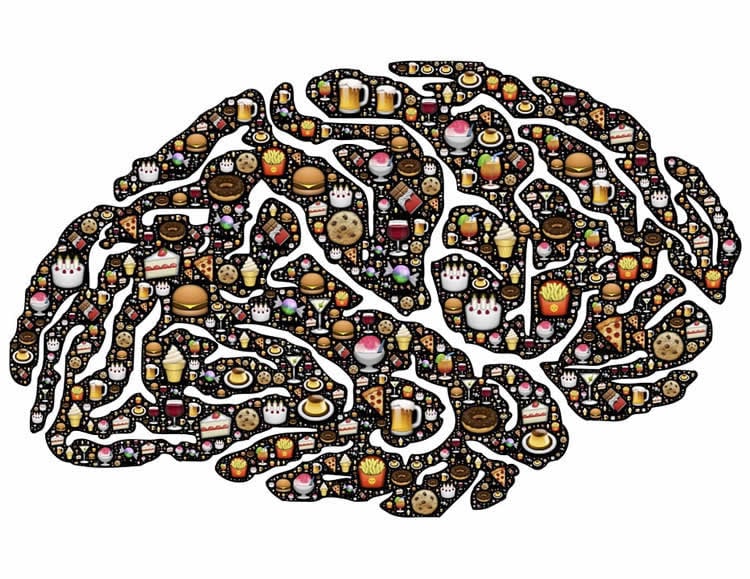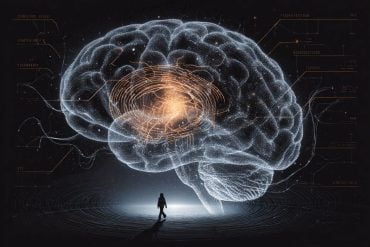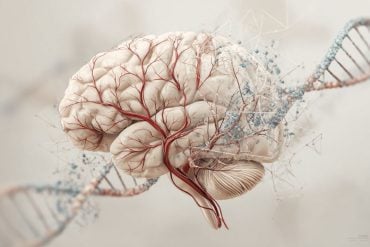Summary: Gray matter volume in the dosolateral and ventromedial prefrontal cortex predicts whether you will choose a health food option or not, researchers report.
Source: INSEAD.
Our indulgence in delicious but unhealthful food may not necessarily reveal a character flaw. Rather, our ability to exercise self-control is linked to our neurobiology, according to a study that has been published in The Journal of Neuroscience in June 2018.
The study was conducted by a team around Hilke Plassmann, the INSEAD Chaired Professor of Decision Neuroscience, consisting of Liane Schmidt of the Brain and Spine Institute (ICM) of Sorbonne University & the French National Institute of Health and Medical Research (INSERM), Anita Tusche of the California Institute of Technology, Nicolas Manoharan of the Sorbonne-Universités-INSEAD Behavioural Lab, Cendri Hutcherson of the University of Toronto, and Todd Hare of the University of Zurich.
How we choose what we eat depends on two main mechanisms, models in the budding field of Neuroeconomics show. We first attribute a value to different attributes such as the tastiness and healthfulness of a food. We then pick the food with the highest overall value after considering the importance we place on each of the attributes.
To investigate whether there are brain structures that predict an individual’s ability to choose healthful foods, the study looked at the food choices of participants in four experiments and anatomical imaging data of their brains while they were making their choices.
Seventy-eight women and 45 men took part in the four experiments. In three of the experiments, participants were placed inside an MRI scanner doing an identical task. They were shown photos of food items and were asked how much they wanted to eat a specific food at the end of the experiment. They were told to make their decisions based on three conditions: their usual preference, focusing on the tastiness of the food, and the healthfulness of the food.
In the fourth experiment, participants were told to pick a food item by either choosing as they normally would, indulging in a food item, or refraining from what they crave. This group of participants was also told to state the price they would pay for a food item to obtain the right to eat at the end of the experiment, with prices ranging from $0 to $2.50.
Structural imaging data from the first three experiments show that the volume of grey matter in the dorsolateral prefrontal cortex (dlPFC) and the ventromedial prefrontal cortex (vmPFC) predicts the choice of healthful food items. In short, participants with more grey matter volume in the two brain regions displayed more discipline in their food choices by placing greater importance on the healthfulness of food items or less on the tastiness when asked to focus on the healthfulness of the foods.
The outcomes of the fourth experiment confirmed the findings of the other experiments. Also in different participants and a different task, the grey matter volume in the vmPFC and dlPFC predicted dietary self-control. Together, the results showed for the first time that differences in the neuroanatomy of the dlPFC and the vmPFC influence individuals’ ability to make healthy food choices.
Combating food-related disorders
The findings of this study could be a first step for further research helping to find a better assessment and through it treatment of eating disorders characterized by dysfunctional control abilities like anorexia nervosa and binge eating, They could also aid the early diagnosis of other food-related disorders such as obesity by helping to identify as risk patients..
“It is not always very clear how to assess these disorders. The field of psychiatry is currently searching for more biological markers in addition to their existing methods. A certain pattern of brain structure could potentially be one of those markers,” said Hilke Plassmann.
“We can also use this to characterize people who might be at risk for eating disorders. Diagnosing cases of obesity, for example, is usually straightforward. But structural brain scans could potentially help to prevent obesity by identifying overweight people whose underdeveloped self-control puts them at risk of becoming obese later in life.” added Liane Schmidt.

The findings of the study do not imply that people’s self-control is constrained by biologically predetermined limits. In what scientists call “neuroplasticity”, the human brain has the capacity to adapt to changing situations. Indeed, grey matter volume, like a muscle, can be developed with exercise.
That means people can strengthen their self-control with the help of neurofeedback exercises. “In the future, we may be able to come up with brain-based interventions, so that you can change the grey matter density in these regions,” said Plassmann.
Implications for healthcare policy
As government policymakers seek to reduce the significant costs of public healthcare services arising from the obesity epidemic, they are trying to create environments that encourage people to make more healthful food choices.
However, they should be mindful that individual neurobiological differences affect how people exercise restraint in choosing what they eat. Some people are more responsive to health-based messaging, others are more responsive to taste-based messaging. The study’s results imply that differences in how people respond could be linked to consumers’ brain structures.
Crafting one set of similar health messages for an entire population is therefore most likely an ineffective communications strategy for policy makers.
Source: Chris Howells – INSEAD
Publisher: Organized by NeuroscienceNews.com.
Image Source: NeuroscienceNews.com image is in the public domain.
Original Research: Abstract for “Neuroanatomy of the vmPFC and dlPFC Predicts Individual Differences in Cognitive Regulation During Dietary Self-Control Across Regulation Strategies” by Liane Schmidt, Anita Tusche, Nicolas Manoharan, Cendri Hutcherson, Todd Hare and Hilke Plassmann in Journal of Neuroscience. Published June 20 2018.
doi:10.1523/JNEUROSCI.3402-17.2018
[cbtabs][cbtab title=”MLA”]INSEAD “Your Brain Anatomy May Play a Role in Determining Your Food Choices.” NeuroscienceNews. NeuroscienceNews, 21 June 2018.
<https://neurosciencenews.com/brain-anatomy-food-choices-9409/>.[/cbtab][cbtab title=”APA”]INSEAD (2018, June 21). Your Brain Anatomy May Play a Role in Determining Your Food Choices. NeuroscienceNews. Retrieved June 21, 2018 from https://neurosciencenews.com/brain-anatomy-food-choices-9409/[/cbtab][cbtab title=”Chicago”]INSEAD “Your Brain Anatomy May Play a Role in Determining Your Food Choices.” https://neurosciencenews.com/brain-anatomy-food-choices-9409/ (accessed June 21, 2018).[/cbtab][/cbtabs]
Abstract
Neuroanatomy of the vmPFC and dlPFC Predicts Individual Differences in Cognitive Regulation During Dietary Self-Control Across Regulation Strategies
Making healthy food choices is challenging for many people. Individuals differ greatly in their ability to follow health goals in the face of temptation, but it is unclear what underlies such differences. Using voxel-based morphometry, we investigated in healthy humans (i.e., men and women) the links between structural variation in gray matter volume and individuals’ level of success in shifting toward healthier food choices. We combined MRI and choice data into a joint dataset by pooling across three independent studies that used a task prompting participants to explicitly focus on the healthiness of food items before making their food choices. Within this dataset, we found that individual differences in gray matter volume in the ventromedial prefrontal cortex (vmPFC) and dorsolateral prefrontal cortex (dlPFC) predicted regulatory success. We extended and confirmed these initial findings by predicting regulatory success out of sample and across tasks in a second dataset requiring participants to apply a different regulation strategy that entailed distancing from cravings for unhealthy, appetitive foods. Our findings suggest that neuroanatomical markers in the vmPFC and dlPFC generalized to different forms of dietary regulation strategies across participant groups. They provide novel evidence that structural differences in neuroanatomy of two key regions for valuation and its control, the vmPFC and dlPFC, predict an individual’s ability to exert control in dietary choices.
SIGNIFICANCE STATEMENT Dieting involves regulating food choices to eat healthier foods and fewer unhealthy foods. People differ dramatically in their ability to achieve or maintain this regulation, but it is unclear why. Here, we show that individuals with more gray matter volume in the dorsolateral and ventromedial prefrontal cortex are better at exercising dietary self-control. This relationship was observed across four different studies examining two different forms of dietary self-regulation, suggesting that neuroanatomical differences in the ventromedial prefrontal cortex and dorsolateral prefrontal cortex may represent a general marker for self-control abilities. These results identify candidate neuroanatomical markers for dieting success and failure, and suggest potential targets for therapies aimed at preventing or treating obesity and related eating disorders.






